Hanoi
Hanoi is the communist capital of Vietnam. Here, on a pedestal stands V.I. Le-Nin.
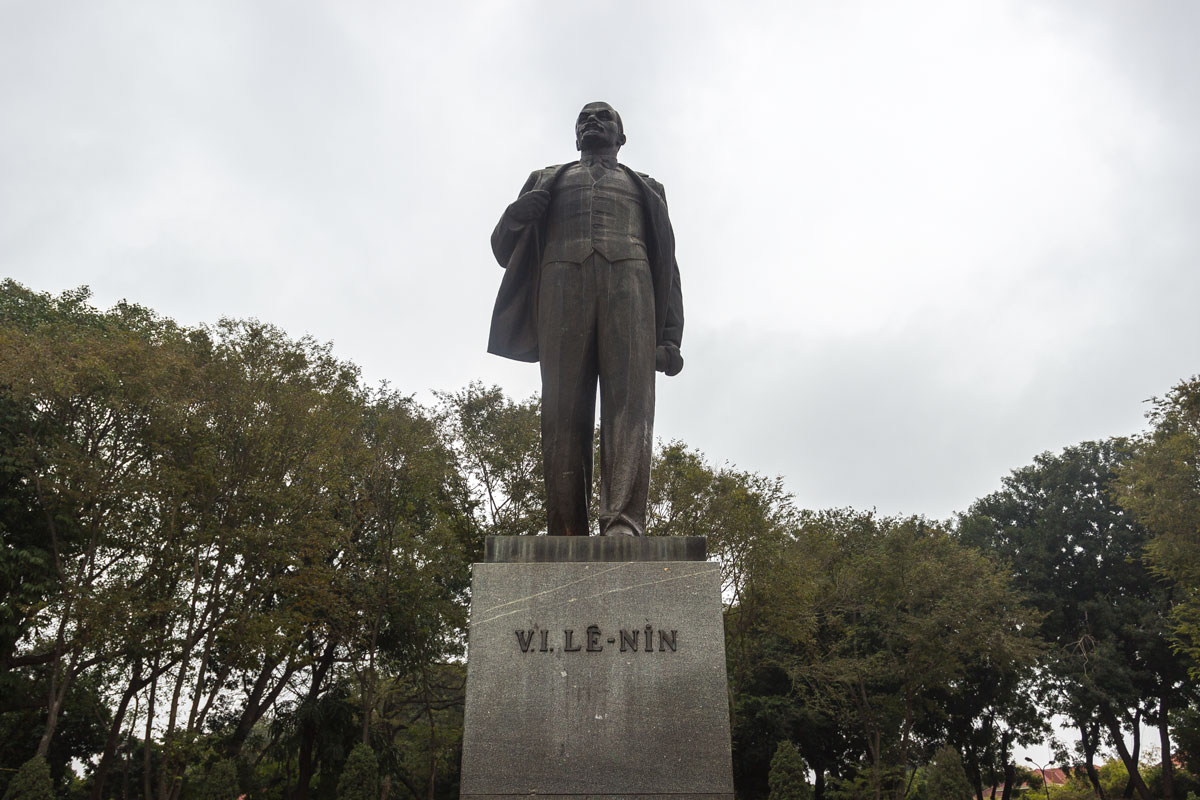
And in the colossal mausoleum at the center of the empty square lies Ho Chi Minh.

Guided tours are conducted inside the mausoleum from 7 to 10 in the morning. Afterwards, the mausoleum is closed so as not to disturb the tired uncle Ho.
The tour of the mausoleum is something else! The whole process takes about an hour, while actually being inside the mausoleum lasts only about two minutes.
First, you have to endure a huge line that extends far beyond the square into the city. All belongings need to be handed over at the entrance, and it happens in two stages. In the first window, still on approach to the square, heavy bags and briefcases are surrendered. If there is a large camera, a tag is attached to it. At first, it is not entirely clear why it is needed, but then the second line begins... at the end of which another window is discovered, where only the camera is now submitted.
Next, tourists walk in a neat column along a zigzag line of paved paths towards the center of the empty square, and one by one, they enter the mausoleum.
There doesn’t seem to be a single photo from inside the mausoleum available online. The control here is so strict that you dare not even for a second reach into your pocket for a phone. The guards in white uniforms with weapons slung appear ready to shoot anyone who attempts to photograph the sacred place.
Therefore, at first, I thought of writing a long text full of epithets describing the interior of the mausoleum. But then I decided that there is nothing more foolish in the world: you climb the steps, enter a large dimly lit room with something resembling a moat surrounding the central area, and on an island rests a glass coffin with a embalmed corpse sporting its iconic goatee, illuminated by a spotlight. You walk around it along the perimeter in 30 seconds. No stopping allowed — military-like presence in every corner. You think to yourself: what a job, guarding a dead idiot all day. Well, and then you exit from the other side of the mausoleum. That’s it.
And then comes the shock: they hand you back your camera. In other words, it has traveled this entire path somewhere underground at a strictly defined speed and arrived right into your hands at the exit. Well, well! However, for the bags, you’ll have to walk around the entire square to the first window.
Next to the mausoleum, there is a park. Although it’s hard to call it a park, it’s more like a prison yard for walks. I set myself a goal and shoot all the “Do not enter” signs in this park.
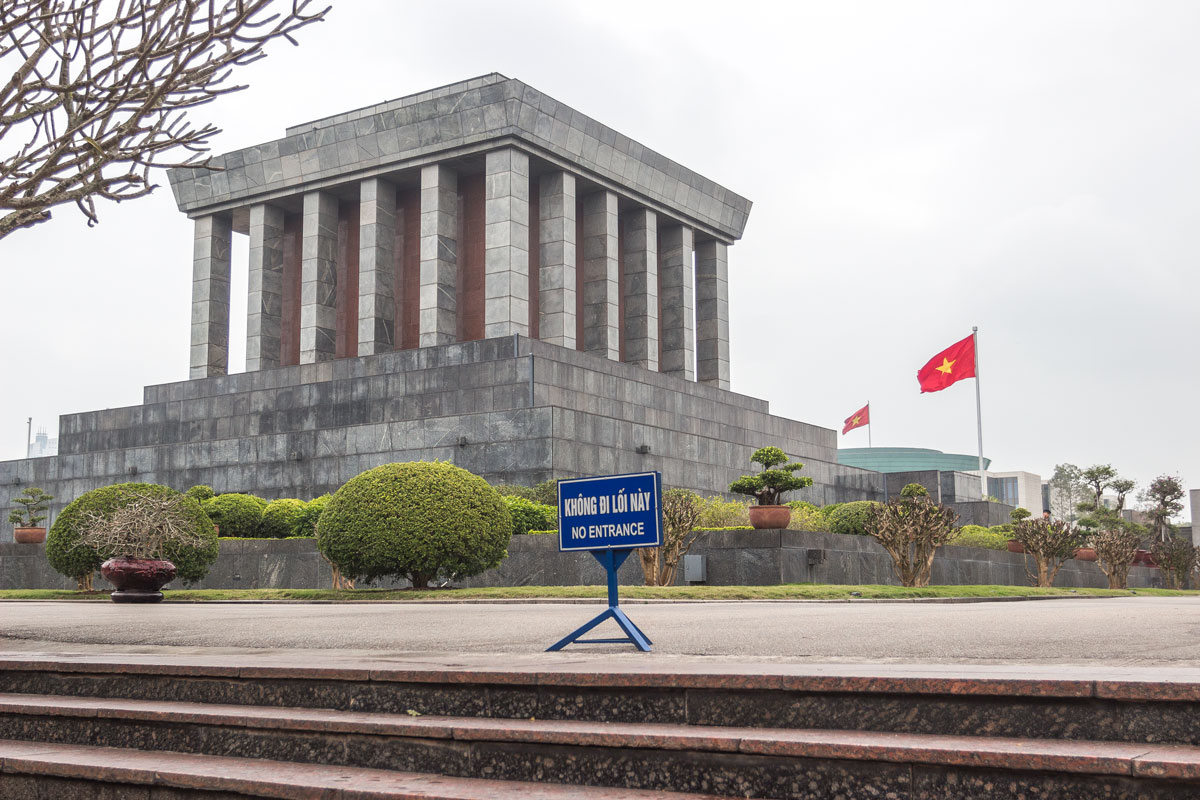
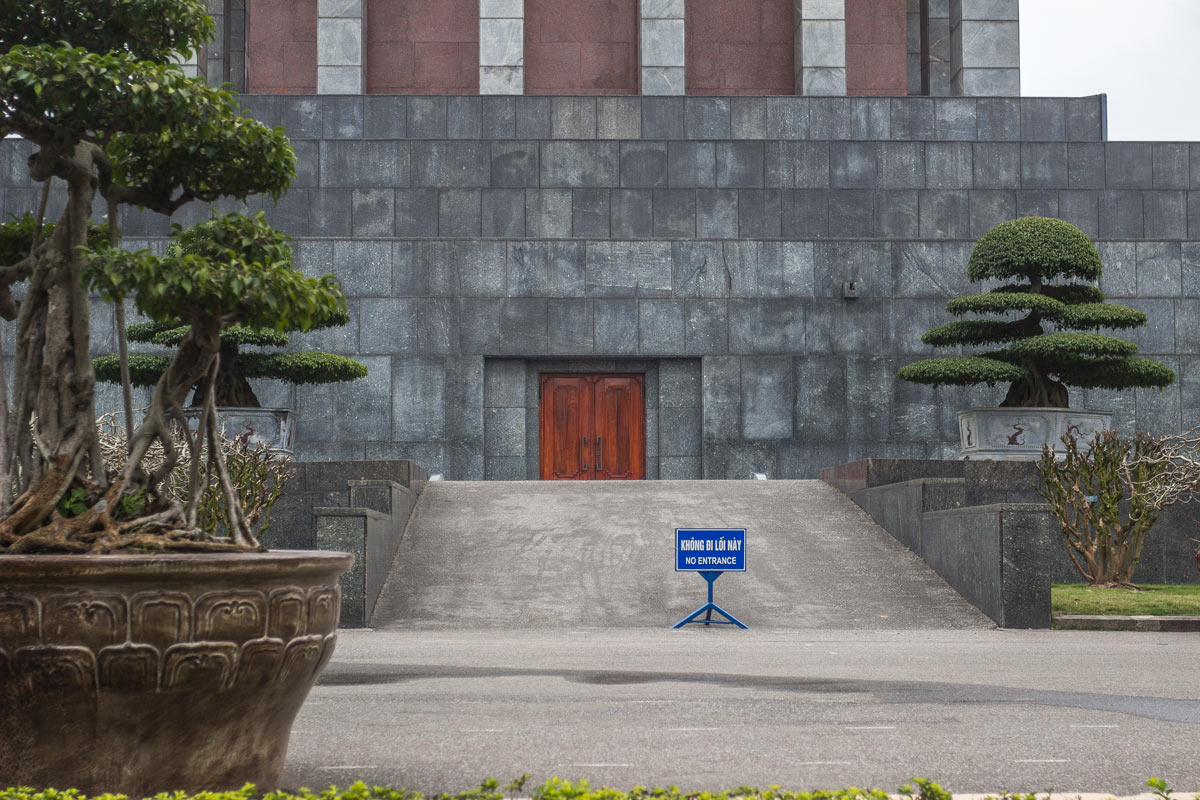



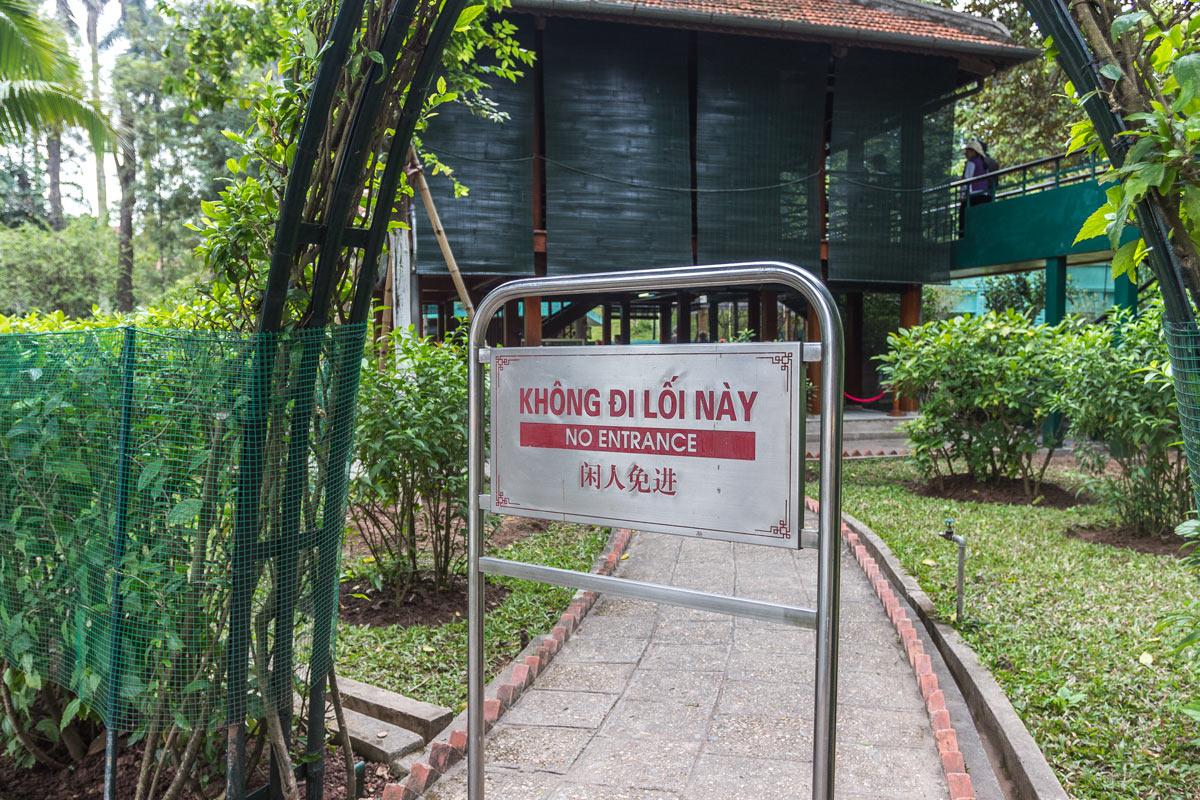

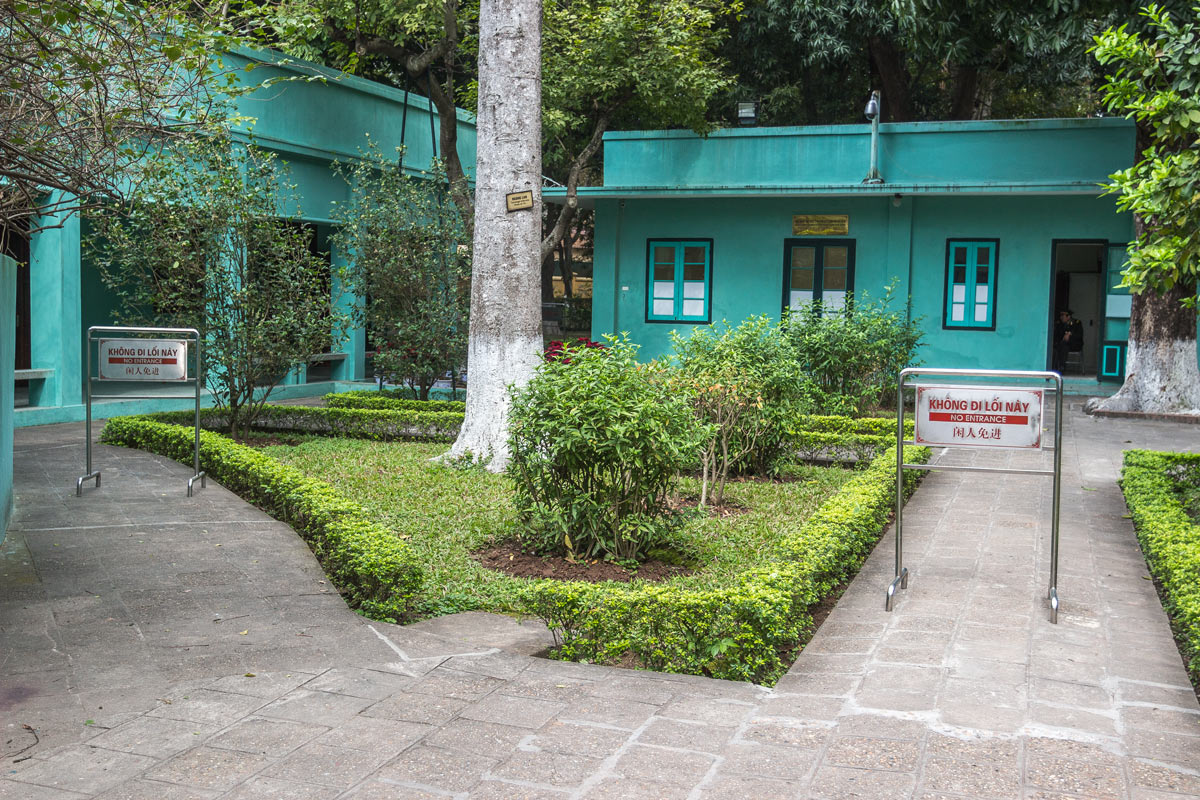
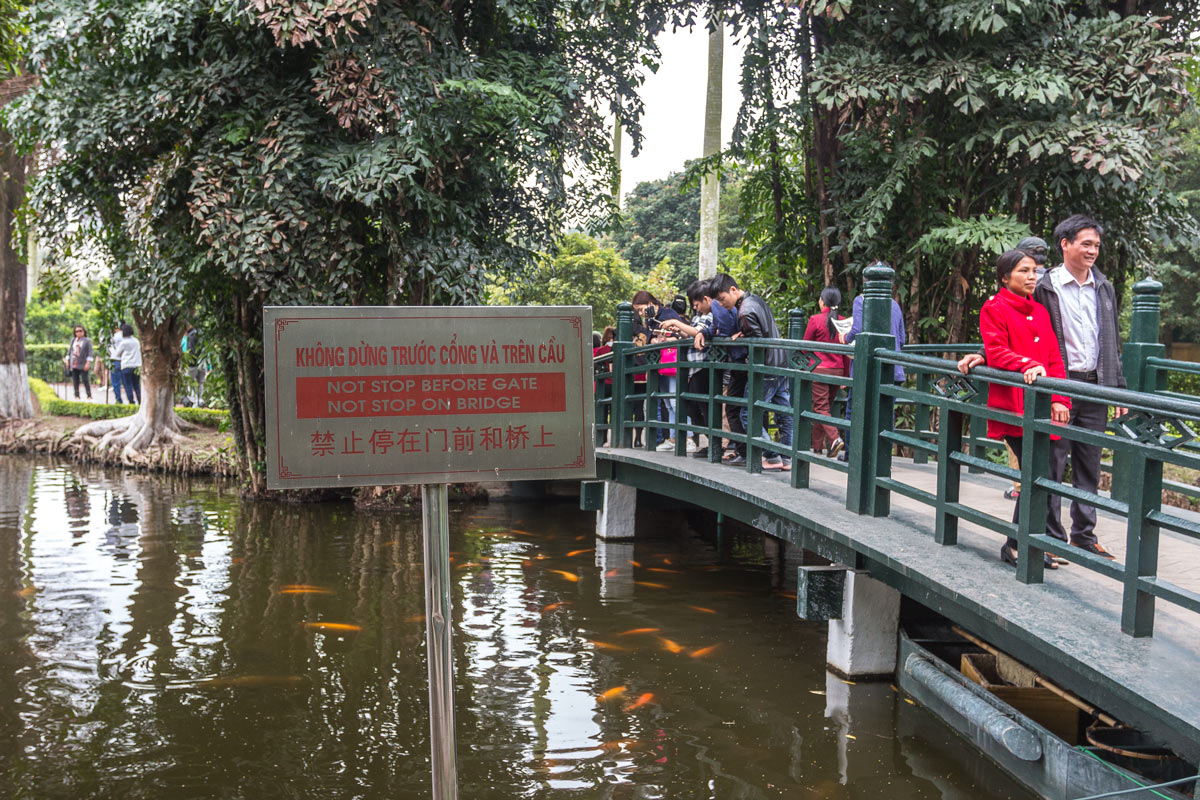

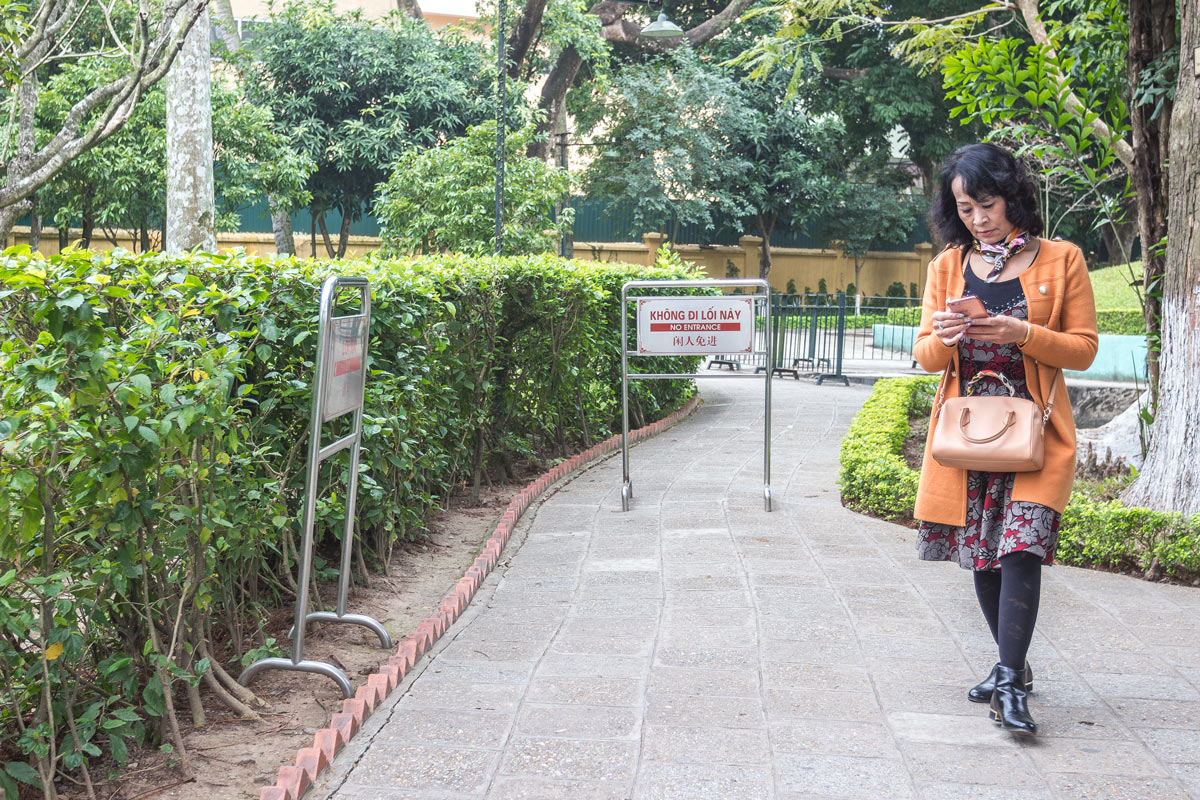


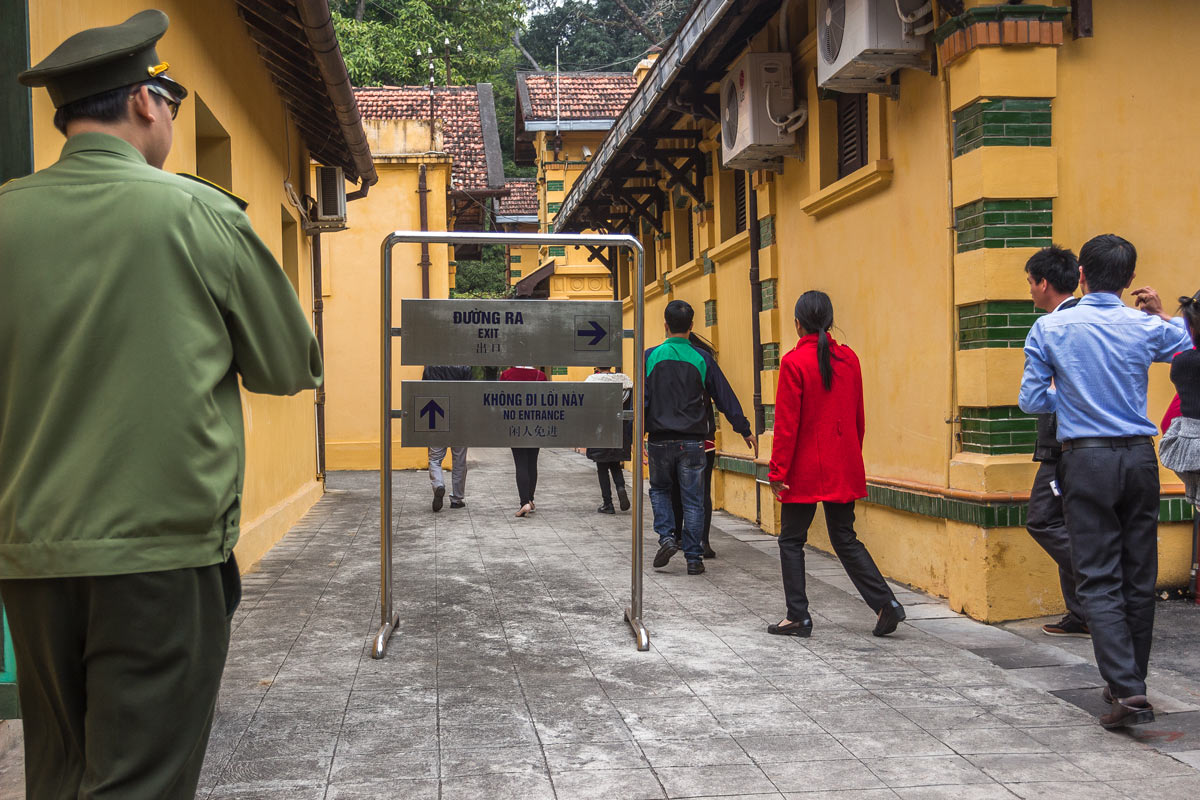
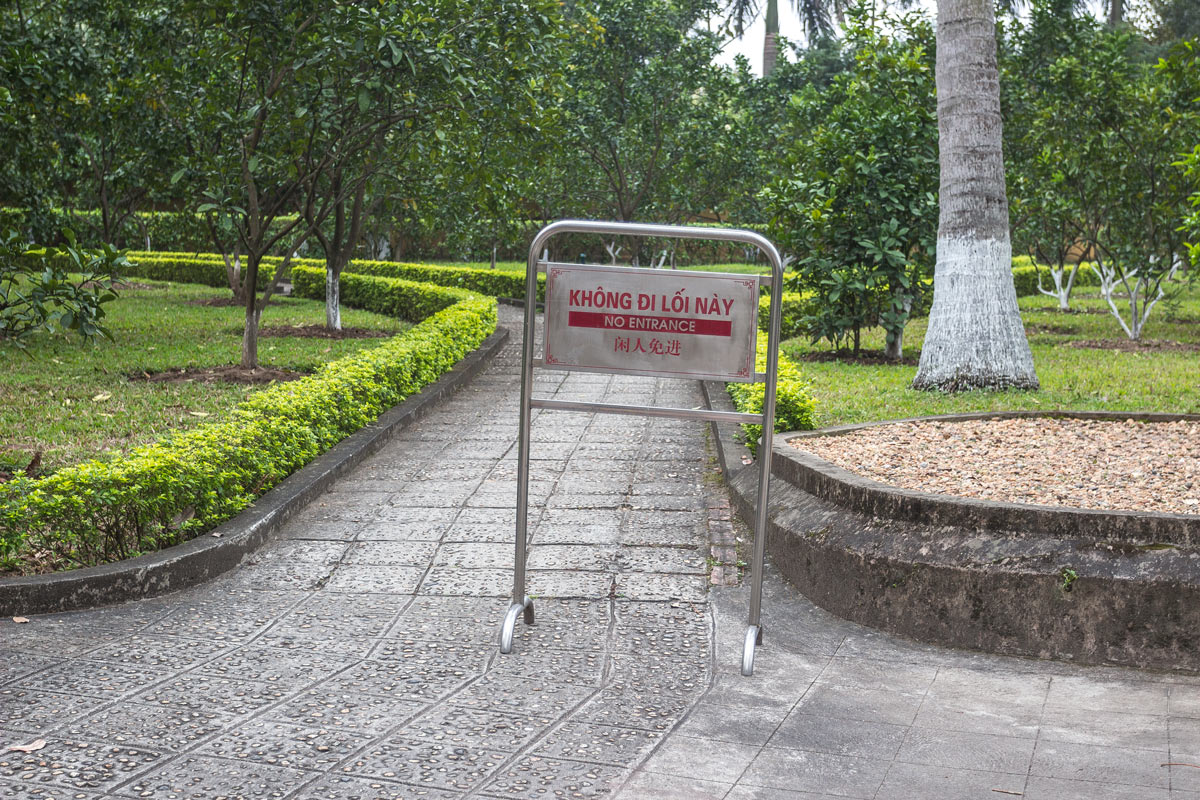

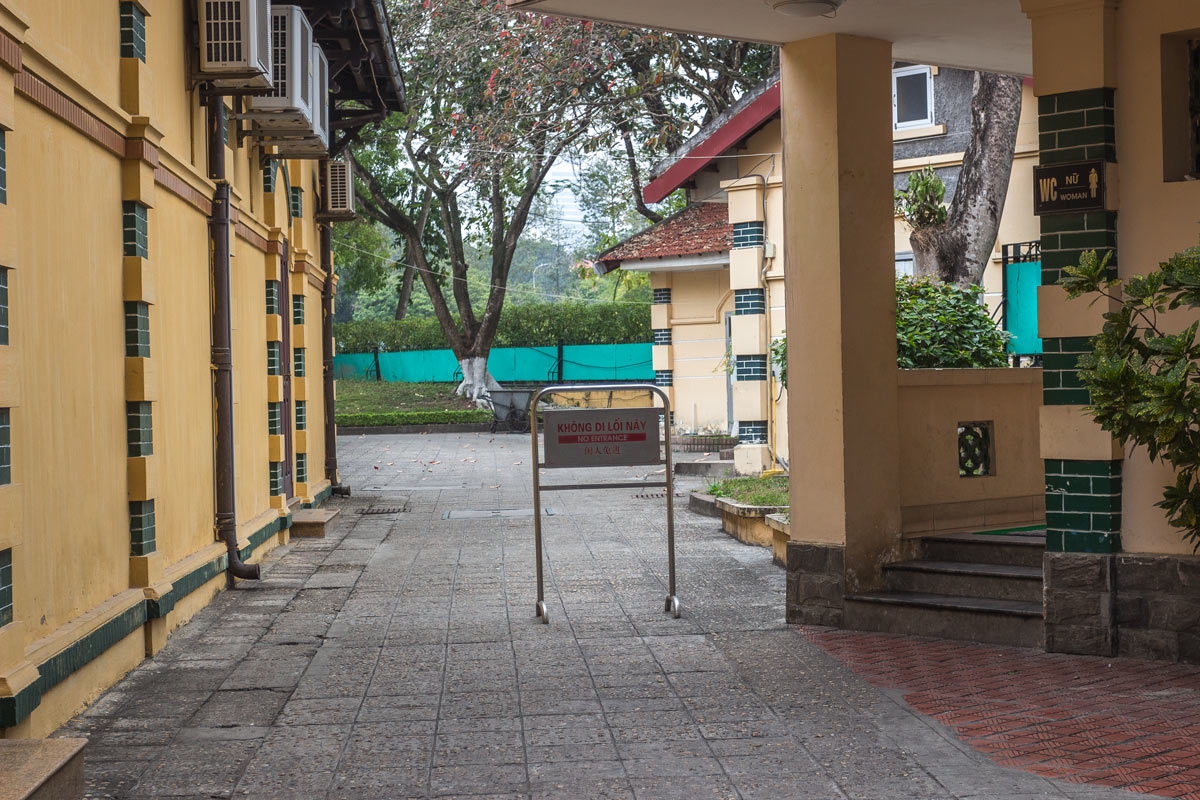
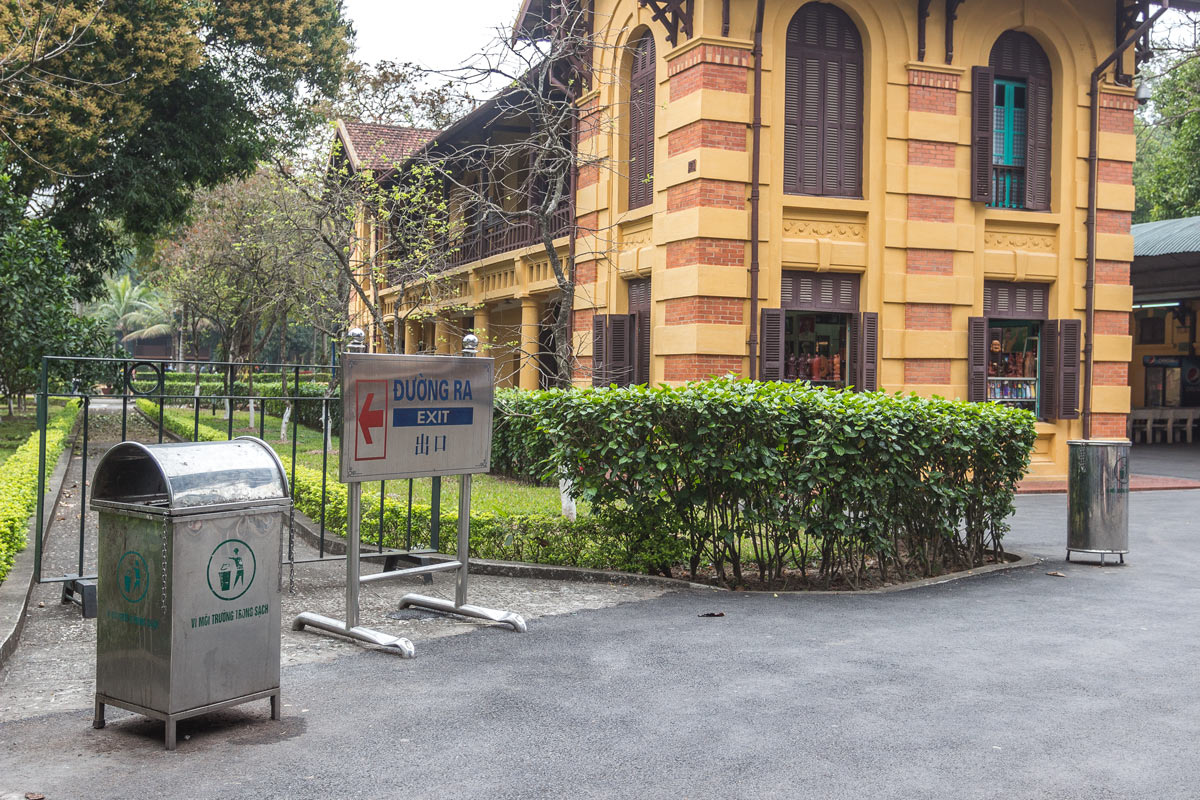
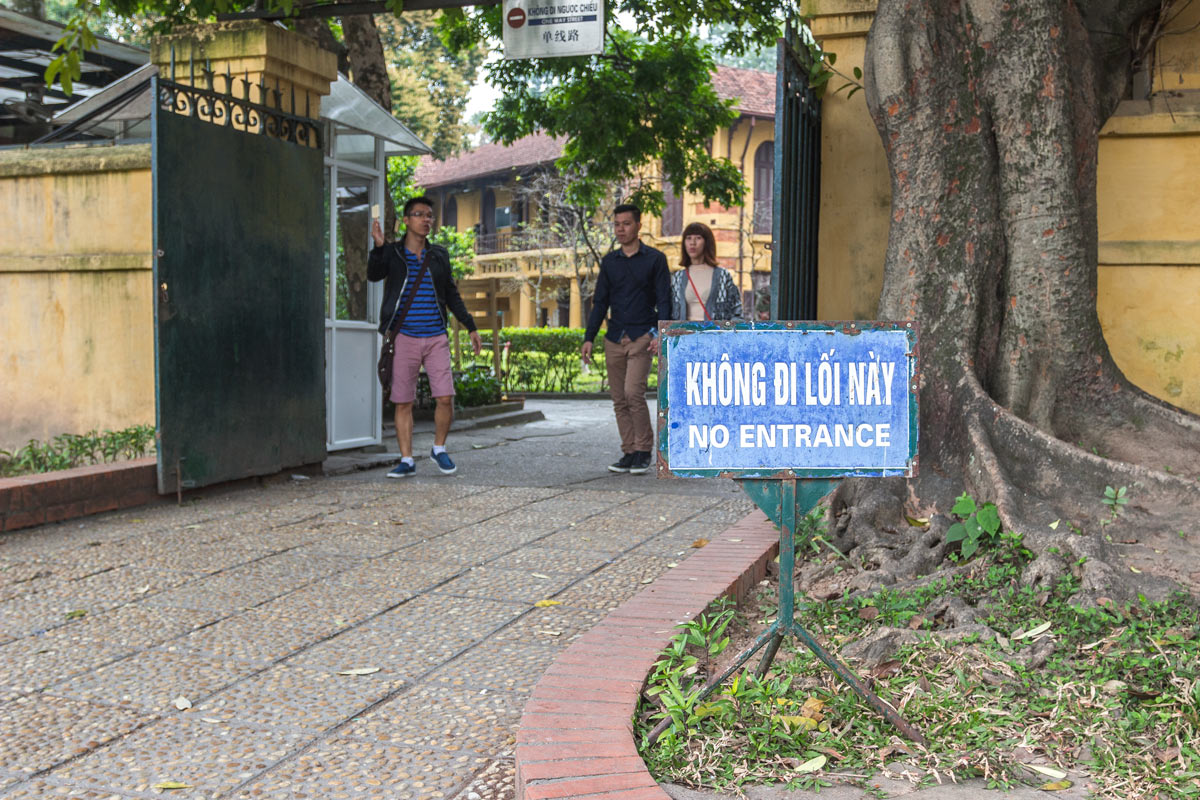
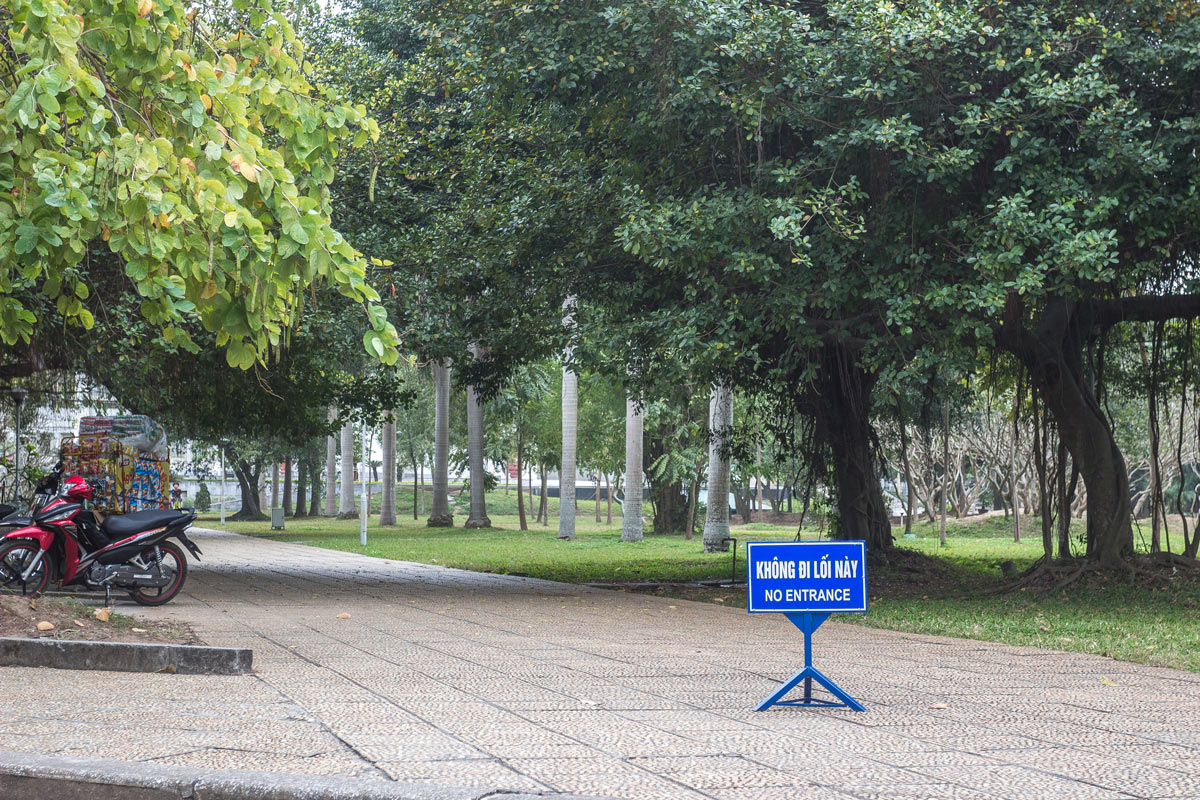


After the park, you arrive at the Ho Chi Minh Museum. Naturally, it’s a tasteless Soviet-style building in the brutalist architectural style.
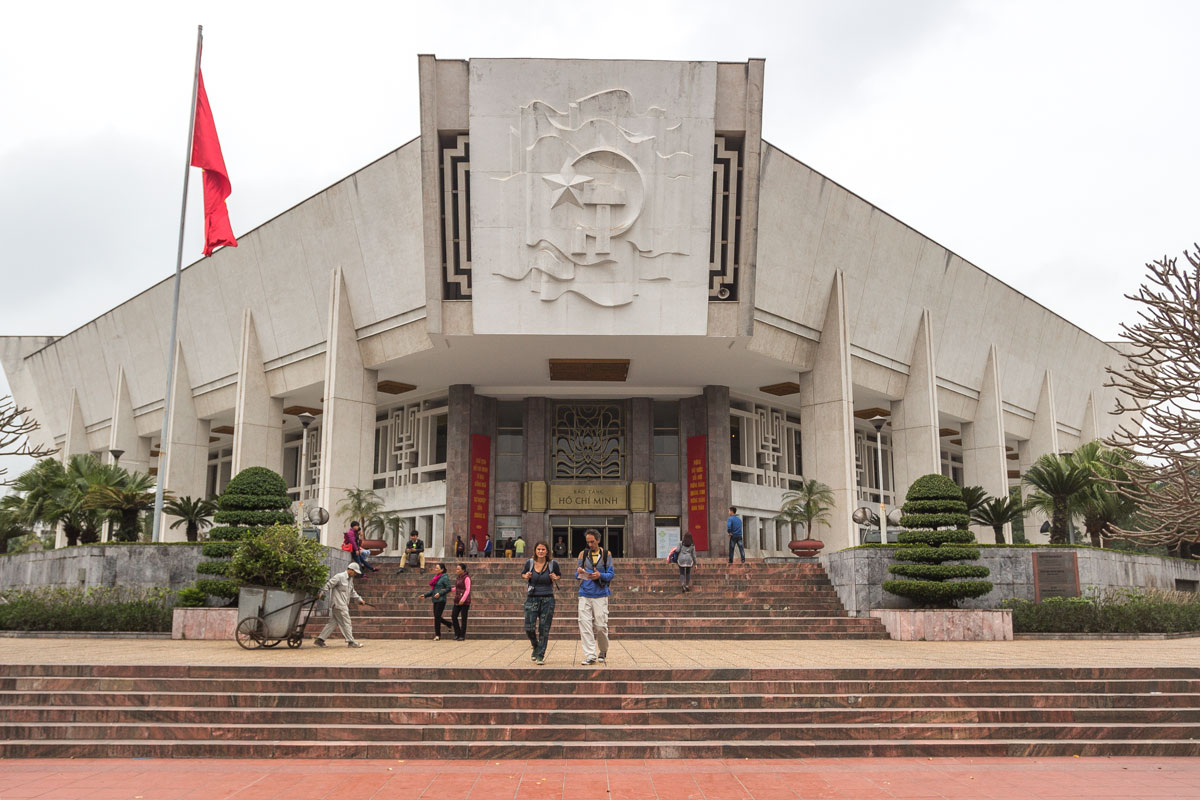
The museum vividly depicts the life of Vietnam. Here is the 4th Plenum of the Central Committee of the Communist Party of Vietnam.

And this, folks, is the 8th Plenum.
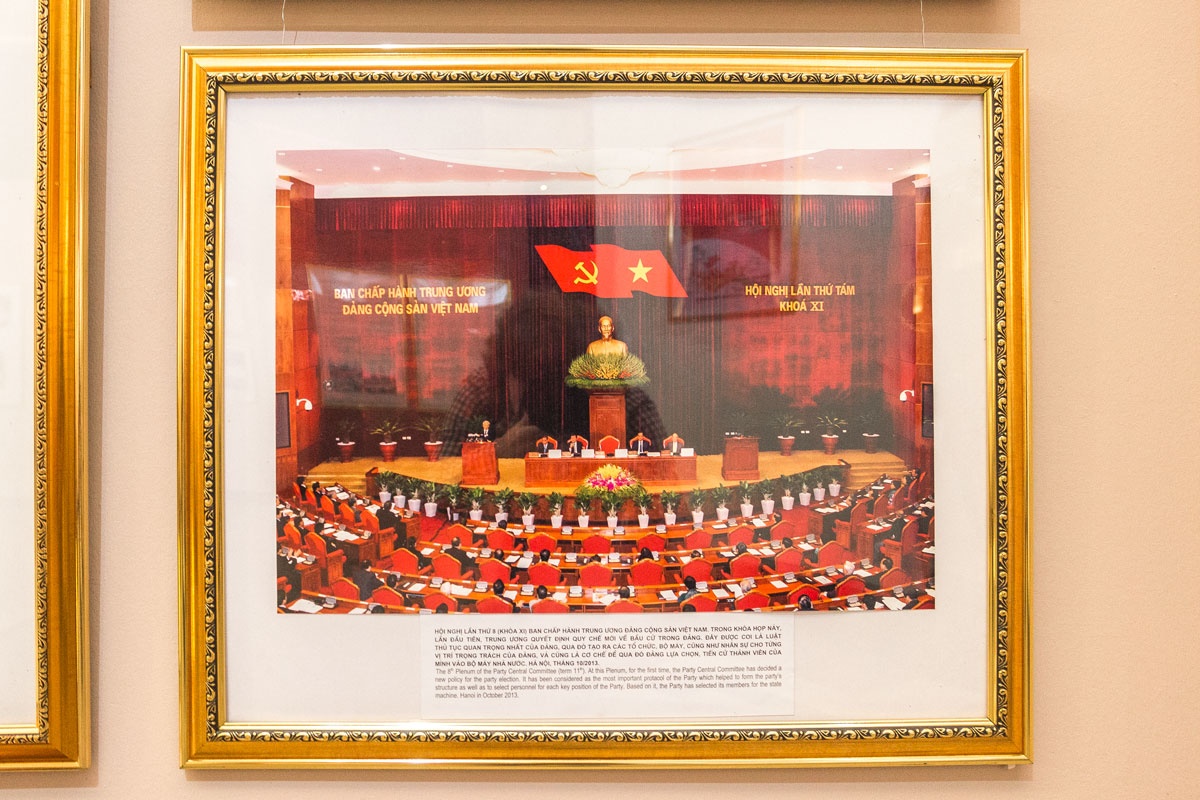
Now proceed to the adjacent stand — here you can see the 10th Plenum of the party.
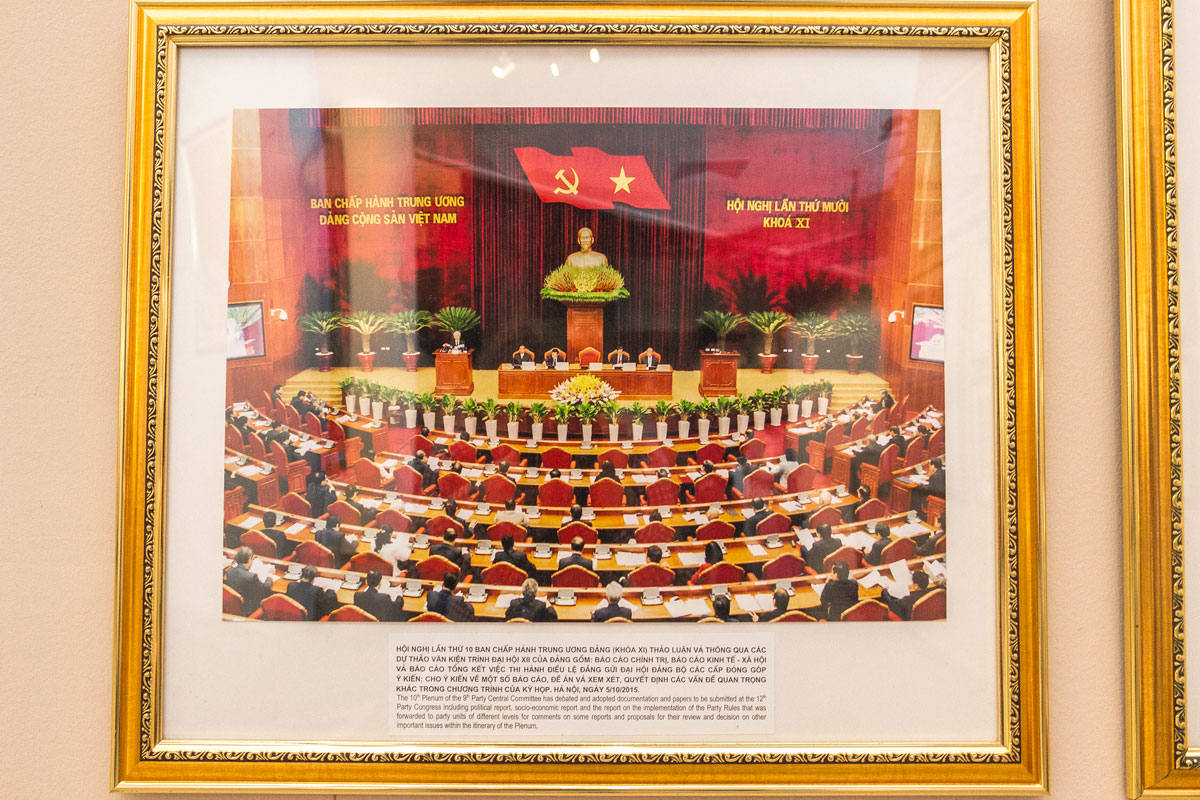
Now let’s figure it out ourselves: which plenum is in the photo? The twelfth one? What?! It’s the first plenum of the new committee!
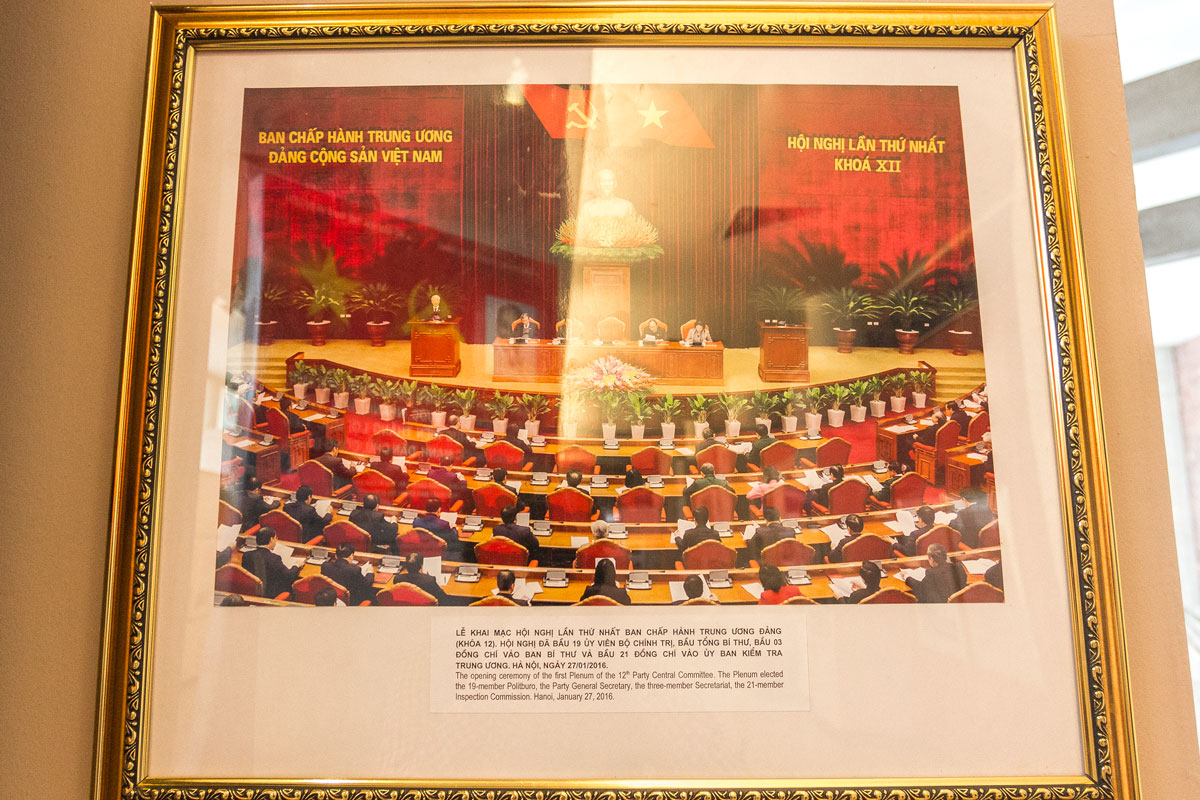
There is nothing else in the museum except for a bunch of quotes from Ho Chi Minh in various languages. The real life of Hanoi begins outside these walls.
⁂
I thought that nobody wears the traditional Vietnamese hat anymore, and it was just a stereotype like the ushanka hat for Russians. It turns out that the “non” is very popular here.

The streets of Hanoi are filled with motorcyclists. They ride everywhere: when you walk on the sidewalk, someone silently approaches from behind and skillfully overtakes. They ride in any weather. When it rains, no problem: they put on a raincoat and continue riding.

Fortunately, there are no tuk-tuks in the country, which I hate so much. There are only rickshaws for entertaining tourists.

There are plenty of scams in Vietnam. A taxi driver picked up somewhere in a tourist area and seating you in the back seat will most likely discreetly add an extra zero to the meter by the end of the trip; a passing motorcyclist will effortlessly snatch the loosely hanging bag from your shoulder.
This fruit vendor first poses cutely for the camera, and then cheerfully puts her arm around me and persistently gestures, “Give me the camera, I’ll take a picture of you!” It’s good that I don’t like having my picture taken.

However, stealing typically doesn’t go any further. Vietnam is quite safe, so you can confidently visit the local slums.
In general, slums are not an offensive term but rather a specific term. Slums refer to areas of a city consisting of self-built housing. Typically, life in slums is not regulated by the government: the population size is unknown, the construction is spontaneous, and sanitation and electricity are either absent or improvised.
Therefore, formally speaking, there are no slums in Hanoi. However, there are areas that closely resemble slums. The construction here is so dense, and the balconies of neighboring houses are tightly attached to each other, creating such darkness that even at noon it feels pitch black.
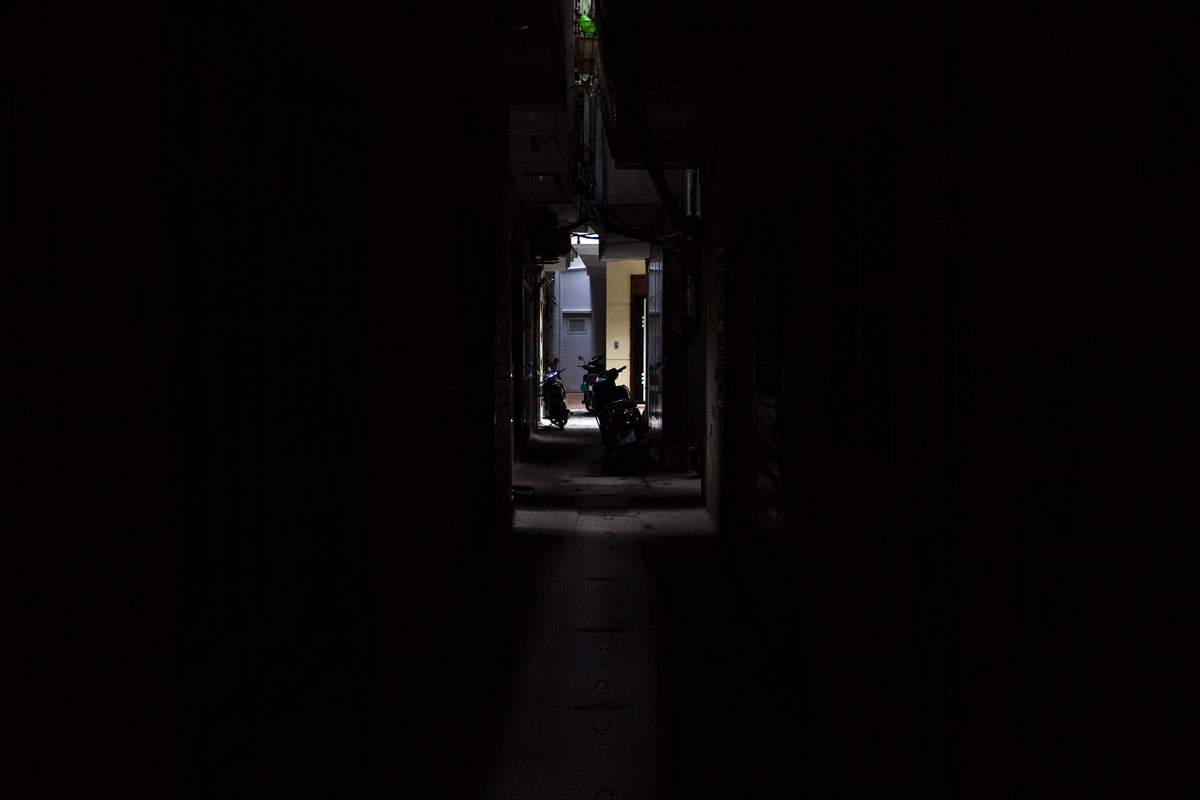
The apartment units open directly onto the alleyways. Vietnamese people take off their shoes right at the threshold, placing their flip-flops neatly on the steps.
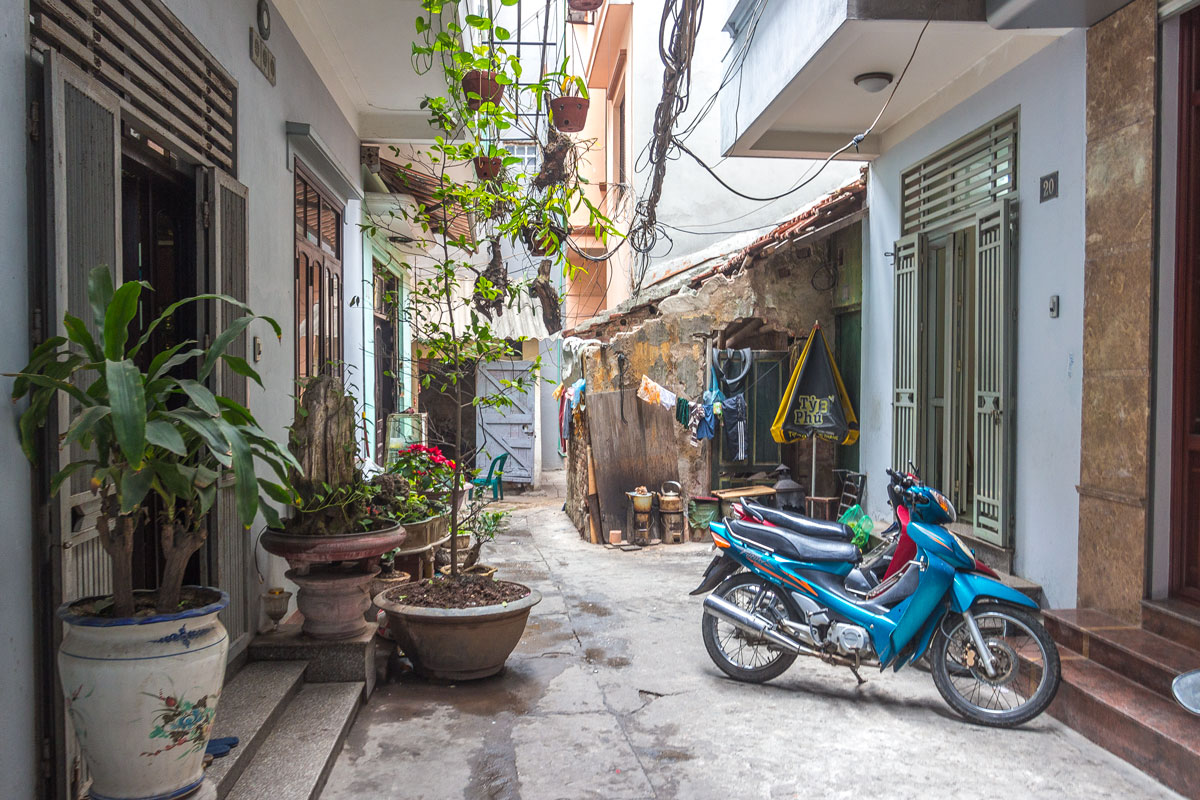
Residents of the upper floors make their way home using narrow staircases.

The slum houses are connected to each other through various passages, bridges, or rooftops.
Moreover, the architecture itself is stereotypically amusing. The most expensive place for construction is along the road. The wider the house, the more expensive it is. Therefore, in Vietnam, they started building extremely narrow houses that extend many meters deep.
Later, due to expensive land and the constantly growing population, new floors began to be added to these narrow houses. Naturally, no one cared about preserving the historical appearance of the buildings. Besides, it was impossible to do so. Therefore, the additional structures were made from whatever materials were available, typically using iron sheets and low-quality concrete.
Now every other house in Hanoi looks like who knows what.
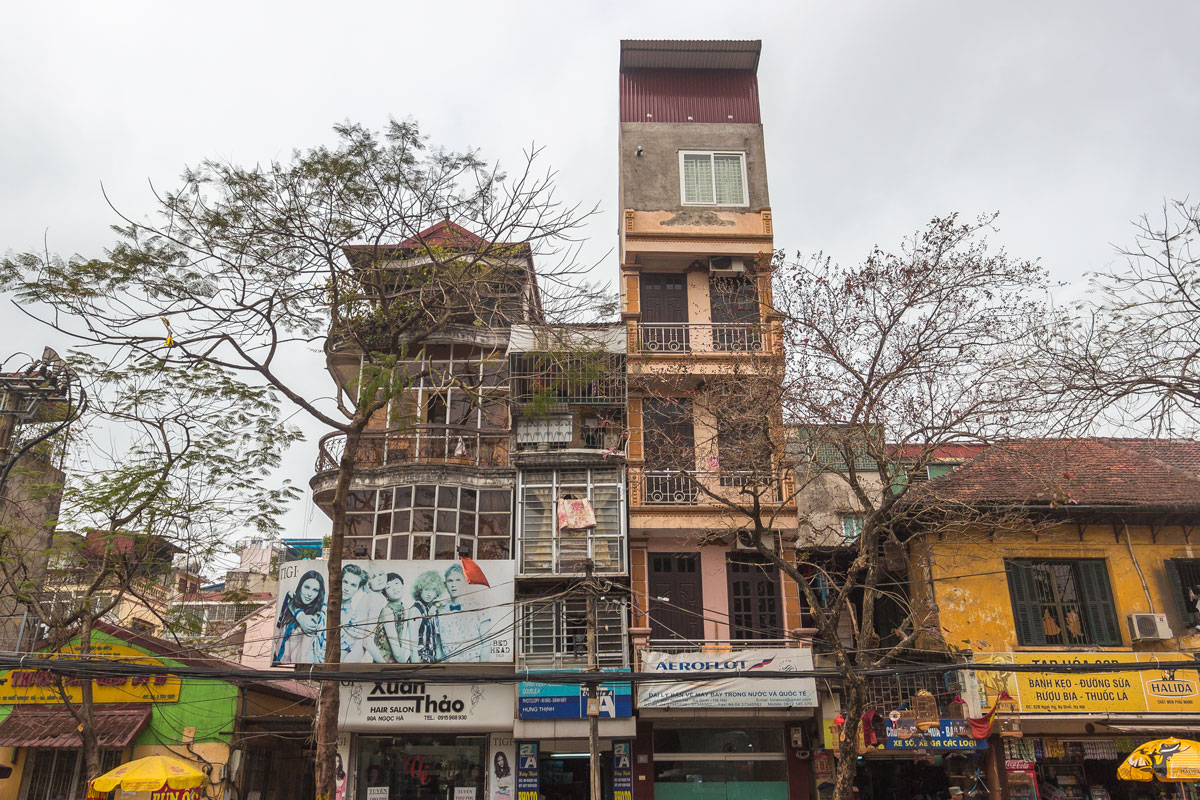
Complete chaos. Literally house upon house.
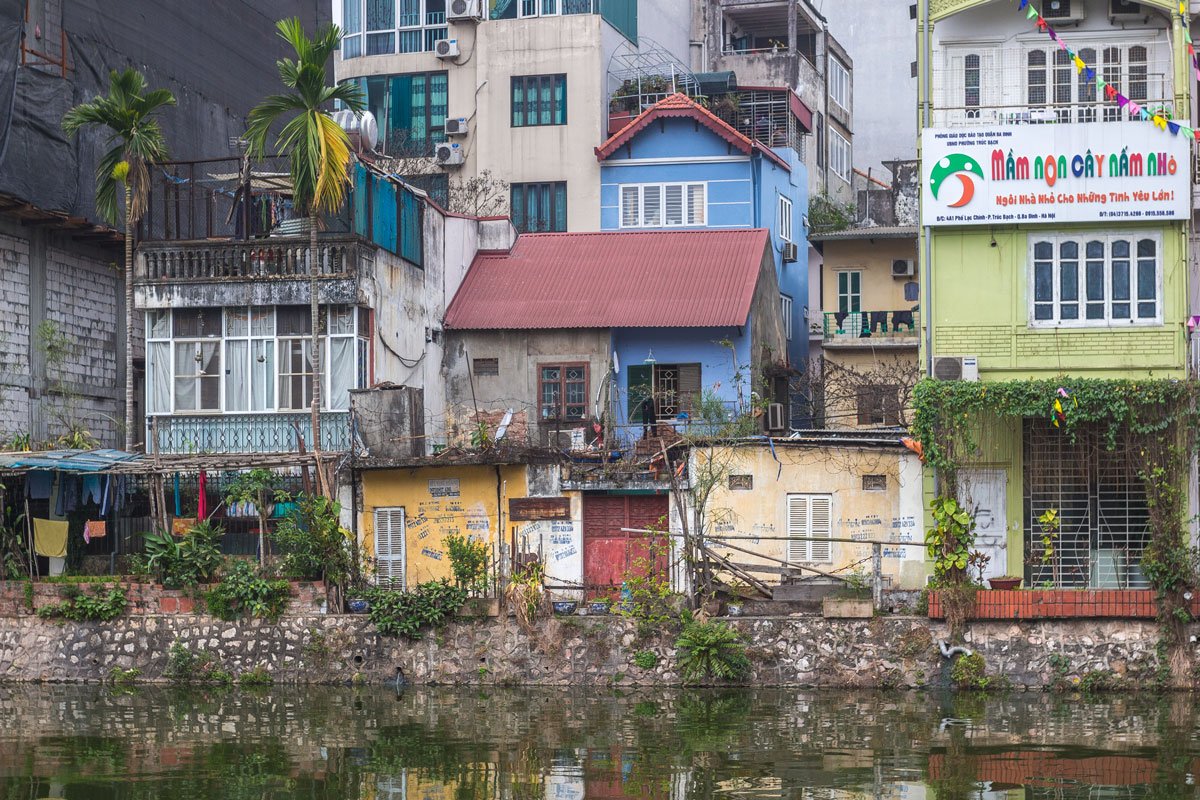
The most frightening thing is when houses alternate in height: bare concrete walls without windows jut out sideways.

Trade flourishes in the alleyways. Shops open right next to apartments, similar to India and the Middle East.
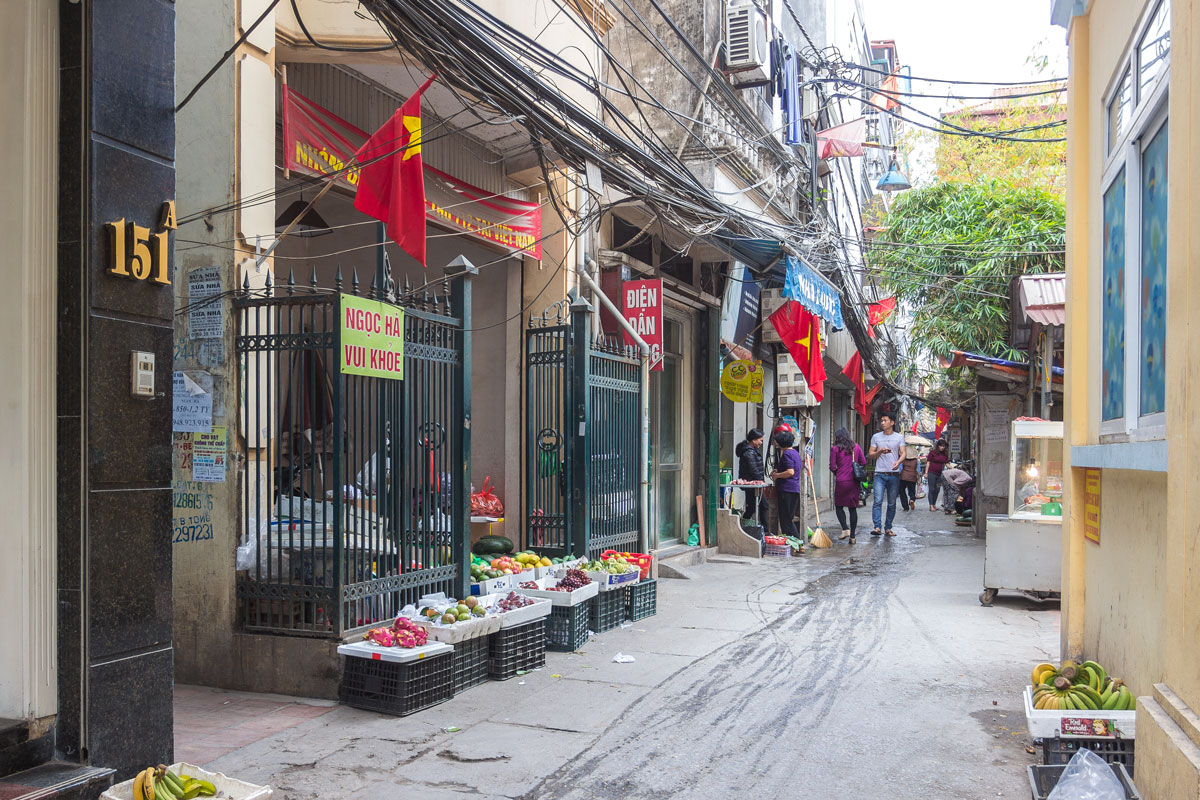
They mainly sell vegetables, meat, and live poultry.
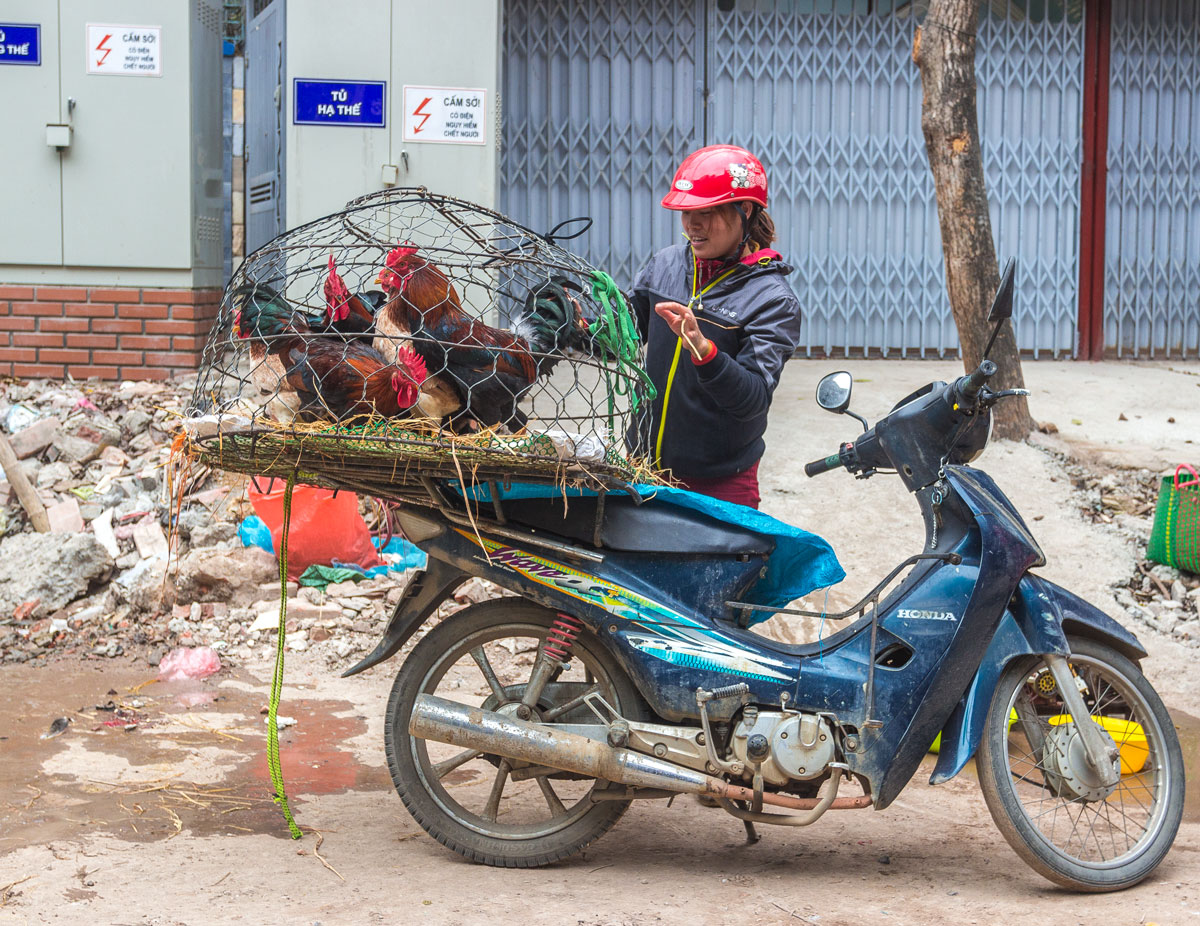
Somewhere among these clusters of houses, with narrow winding alleys that are not shown on every map, and where satellite signals are barely accurate within twenty meters, lies a memorial from the war era — a downed American B-52 bomber.
The wreckage of the airplane, from which little remains, is partially submerged in the water of one of the local ponds. By the way, around this small lake, you can find the wealthiest and most decent houses in the slums.
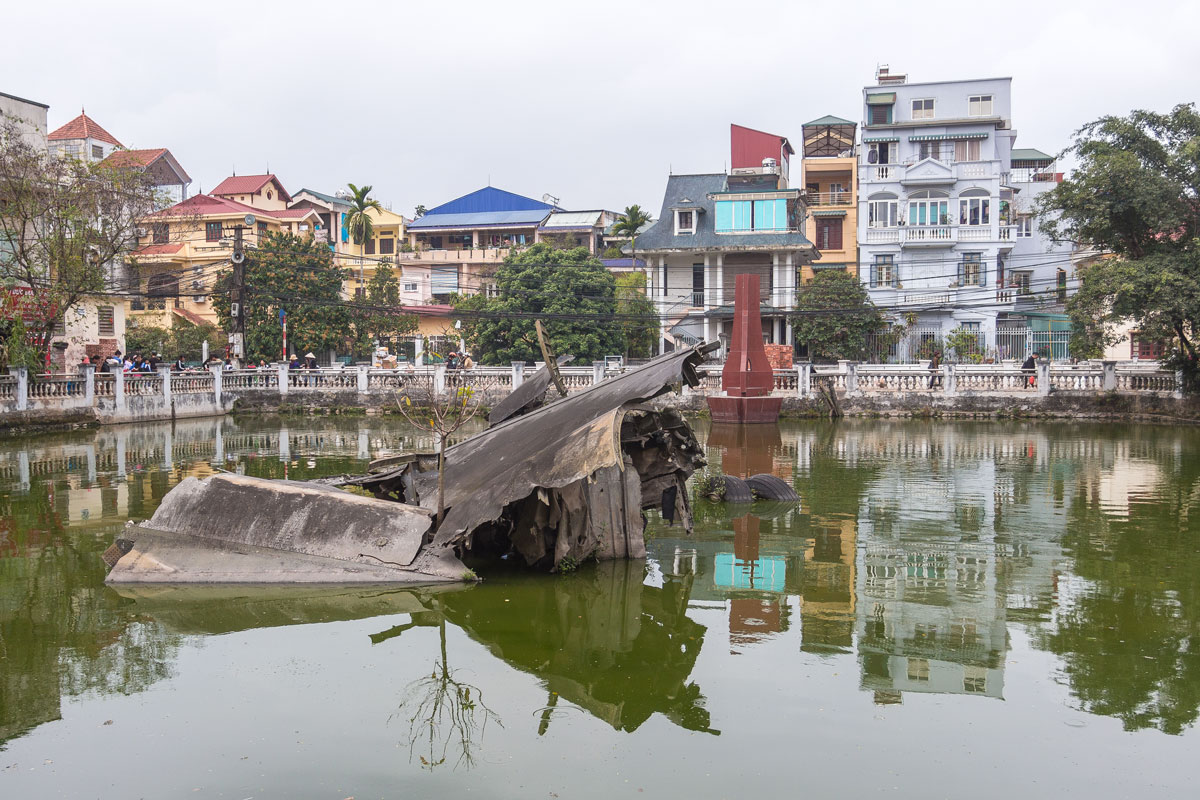
Vietnam is full of war memorials. People here are still obsessed with it, just like in Russia with the Great Patriotic War. Every other monument is about the war. From downed airplanes and French prisons to underground tunnels and spike traps in Saigon, you can’t visit Vietnam without seeing traces of the war.
The second notable war memorial in Hanoi is the monument to John McCain, the same senator who unsuccessfully tried to become the President of the United States. During the Vietnam War, McCain was shot down over Hanoi and taken as a prisoner of war, where he was held for 5 years and subjected to torture to such an extent that he could no longer raise his arms above his head and had to use crutches for a long time.
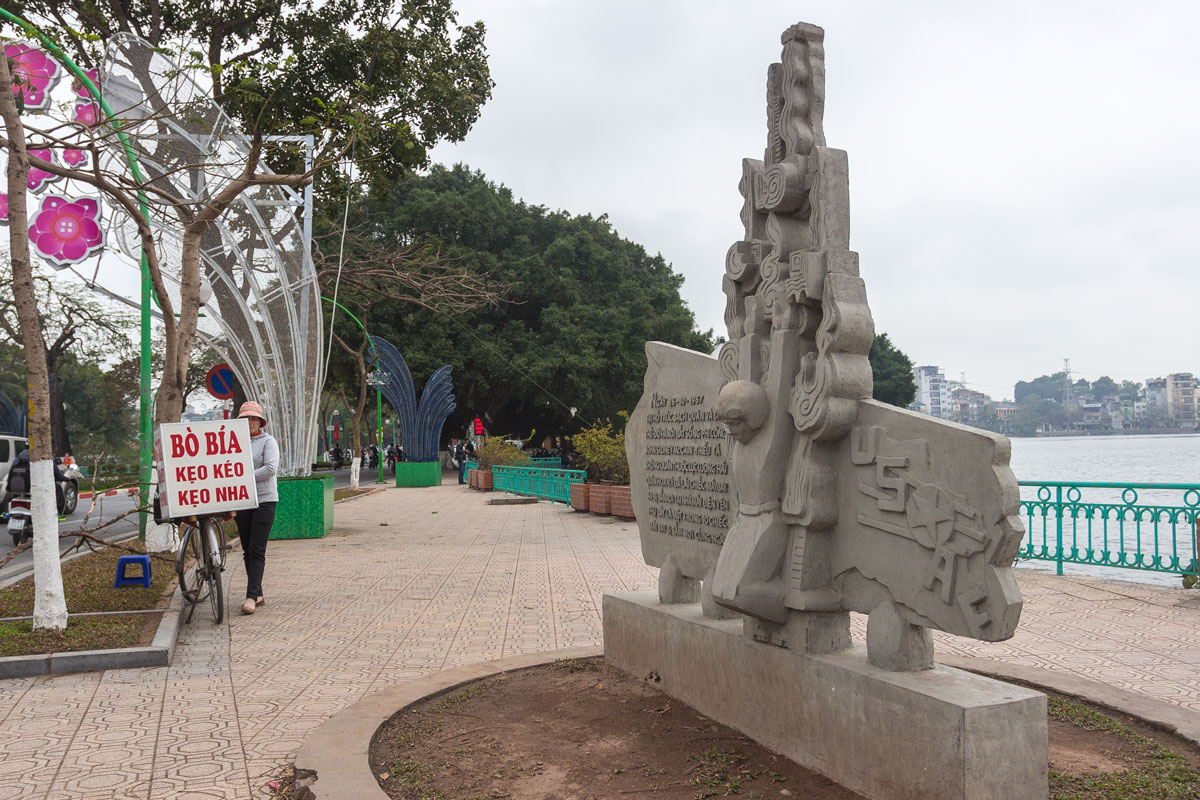
And there, not far away, walks the same Vietnamese person who shot down McCain, or someone similar. Vietnam is full of charismatic uncles in military uniforms and magnificent beards reminiscent of Ho Chi Minh.

From this very spot, there is an excellent view of the city. Skyscrapers in Hanoi can be counted on one hand.
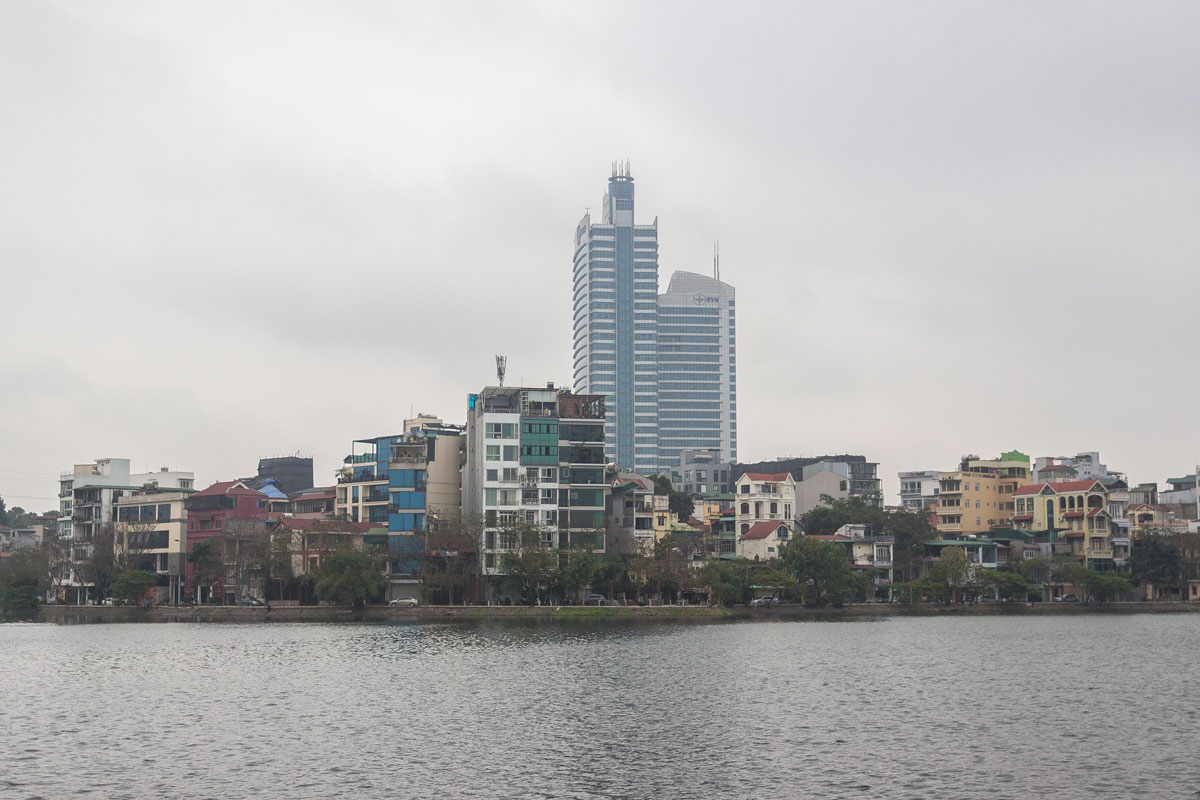

And they all rise amidst the poorest shacks. In the city, there are even areas where houses are built just a meter away from the railroad tracks. Like in Bangladesh. However, trains don’t run on it every half hour.


⁂
While strolling through Hanoi, one needs to spend more than an hour and show remarkable attentiveness to discern what truly lies behind this self-built slum.
In this city, it’s simply impossible to stop and consider anything. The flow of people, cars, and motorcycles is constant; any inattentive pedestrian will be knocked down instantly.
But if you manage to find a quiet oasis in this stream, stop there and look up, a true enlightenment comes: it turns out these are not just abandoned shacks. Most of the houses here are quite decent colonial structures!

Take a close look at this architectural chaos. Each house here has all the elements of good architecture. Beautiful wooden windows and shutters, miniature balconies with columns, red tiled roofs. On top of that, there are air conditioners installed, makeshift floors, and a bunch of advertisements.
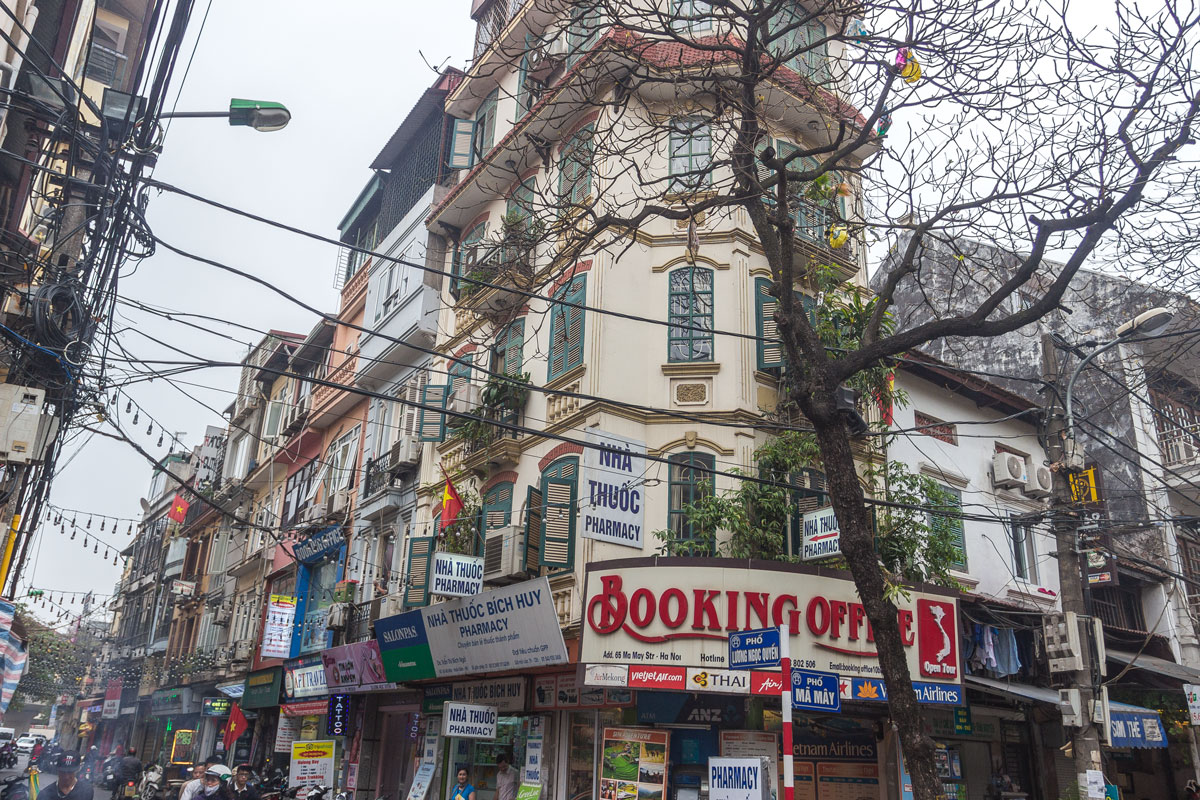
But as soon as you scratch beneath the surface, mentally remove all this Vietnamese clutter, a nearly European city reveals itself to the eye!

Sometimes it’s very difficult to discern. But old France, like a ghost, haunts the traveler in Hanoi.

And the most interesting things start at night. The Old Quarter of Hanoi, a tourist hub, closes its best streets to vehicle traffic.

The whole of Hanoi goes out for a walk!
There is no trace left of the gray and gloomy city. At night, Hanoi lights up with thousands of lights, endless sales take place on the streets, musicians play, and crowds of tourists roam around.

The old quarter is bursting with hipster cafes. In one of them, I had an incredibly delicious national dish made with excellent meat and glass noodles, and drank the best coffee of my life. The taste of Vietnamese coffee, with the added whipped egg yolk, still lingers on my tongue in my memory, as I write this story, even after half a year. I never managed to prepare anything remotely similar at home.

That was Hanoi, the capital of North Vietnam. A beautiful city at heart, but much has been lost during the communist era and decades of subsequent wild capitalism.

It’s time for us to head to Saigon, or Ho Chi Minh City, the capital of South Vietnam. The reader will surely want to compare what this city has become and its former status as a center of conflict, completely different from Hanoi.


